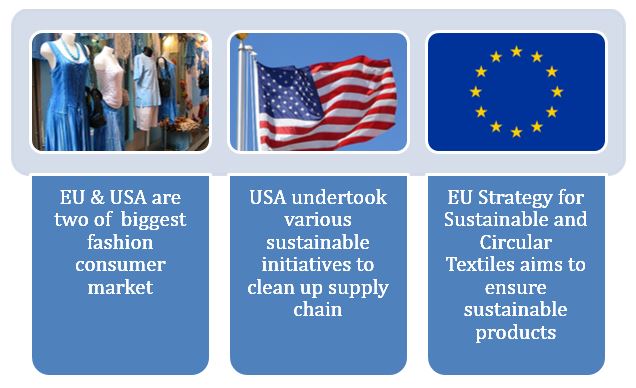Every year, the fashion industry generates a massive amount of waste globally – an estimated 92 million tons of textile waste is created each year. For instance, apparel contributes to half a million tons of microfiber pollution into the ocean, the equivalent of 50bn plastic bottles. Due to its enormous volume of waste, non-biodegradability nature, and consumes vast amounts of resources in manufacturing. Not to mention, fashion trash and its implication on soil, water, and the overall environment is a headache for the wider community.
In terms of recycling or circularity, an insignificant percentage of textiles are collected for recycling or reuse. The EU and USA are two of the biggest fashion consumer market. And according to the most recent United States Environmental Protection Agency (EPA) data, the US generates just over 17 million tons of textile MSW (Municipal Solid Waste) per year. That is around 112lb per person, according to the latest census statistics. In the US, 66% of all unwanted clothes and textiles are landfilled. Less than 15% are recycled. The rest (19%) are burned.
While the European fashion industry produces an estimated 11 million tons of waste yearly. Only 1% of this waste is recycled.
The good news is that for the last couple of years, the pathetic scenario of the fashion industry is observing a turnaround. Here we will look into the matter of how the USA and EU are tackling the fashion waste scenario.
USA initiatives for resolving the wastage issue
The United States has taken initiatives involving cross-industry stakeholders and approaches to address the fashion wastage issue. Including:
- Sustainable fashion advocacy: The US govt. has reinforced numerous sustainability initiatives. With the aim to promote sustainable practices, reduce waste, and increasing transparency in the fashion supply chain.
- Consumer education: Efforts have been made to increase consciousness among fashion consumers about the environmental impact of fast fashion and the significance of making sustainable choices. According to 2021 Statista data: around 34% of Gen Z want to buy more sustainable fashion items if they were more widely available in the USA. Various programs and campaigns have been launched to educate consumers regarding responsible consumption and the benefits of picking eco-friendly and ethical fashion.
- Collaboration with industry stakeholders: The US government has fortified collaboration between government agencies, fashion brands, retailers, and NGOs to develop and implement sustainable practices. This includes sharing best practices, conducting research, and setting industry standards for reducing waste and improving sustainability.
- Textile recycling programs: Initiatives have been undertaken to promote textile recycling and divert clothing from ending up in landfills. Some cities have implemented textile recycling programs, providing drop-off locations for used clothing and textiles. These materials are then sorted, recycled, or repurposed.
- Sustainable fashion innovation: The US government has supported research and development efforts in sustainable fashion technologies and materials. Funding has been allocated to encourage the development of eco-friendly fabrics, dyeing processes, and manufacturing techniques that reduce waste and environmental impact.
- Regulation and policy development: The government has explored the possibility of implementing regulations and policies to address fashion wastage. While specific regulations may vary, the focus is typically on promoting transparency, responsible production practices, and reducing the use of hazardous substances.
Secondhand stores are assisting some textile manufacturers in the United States reduce waste. They’re hiring article collectors and putting people to work in the industry. Thrifting reduces the demand for manufactured goods and the emissions of synthetic materials.
The EPA wants to create new markets for recycled materials so businesses can profit from recycling. This implies that new regulations or financial incentives could boost demand for recycled materials. A ‘Demand Challenge partnership program’ is proposed in the plan to encourage businesses to use more renewable energy.
Fashion designers are working to combat the widespread problem of clothing waste. Authorities, collectors, recyclers, and resale businesses collaborate with the #WearNext initiative to collect donations across the city and repurpose unwanted items. The Ellen MacArthur Foundation’s Make Fashion Circular initiative is driving a global effort to develop a circular business model for the garment industry.
Europe’s initiatives for resolving the wastage issue:
The European Union (EU) has launched several initiatives to combat textile fashion waste. The European Commission (EC) has released the long-awaited EU Strategy for Sustainable and Circular Textiles, part of a new set of European Green Deal initiatives to make sustainable products the norm. It lays out both a vision and actual activities aimed at ensuring that by 2030, textile goods placed on the EU market are long-lasting and recyclable, made from recycled fibers to the greatest extent possible, free of harmful compounds, and produced following social and environmental rights. The Circular Economy Action Plan, which establishes several targets for reducing waste and encouraging recycling, includes a goal of reusing or recycling 50% of textiles by the given year.
The Textile Strategy outlines several measures to make the textile industry more sustainable, such as requiring all textiles labeled with composition and care instructions by 2025.
Refashion is a project to make the European fashion industry more environmentally friendly. It is a collaborative effort between the European Commission, the French government, and other partners. The project’s goals include reducing the amount of textile waste produced in Europe, increasing the number of textiles recycled or reused, promoting the use of sustainable materials in fashion, and raising awareness of the environmental and social impacts of the fashion industry.
Governments in the European Union have agreed that the destruction of unsold textiles should be prohibited as part of the EU’s green push to reduce waste through increased reuse and recycling.
Textile fashion trash removal necessitates a multi-stakeholder approach. Governments, fashion companies, consumers, and industry groups must work together to implement comprehensive waste management policies, expand recycling infrastructure, and encourage responsible consumption.
Eliminating textile fashion waste can benefit both the fashion industry and the world. Collective action and innovative solutions have the potential to transform fashion, reduce waste, and protect the environment for future generations.
